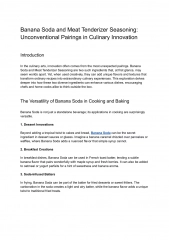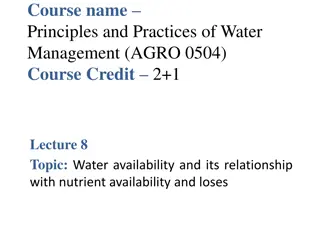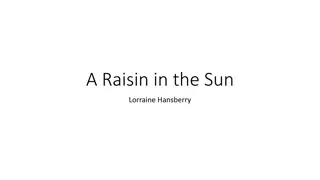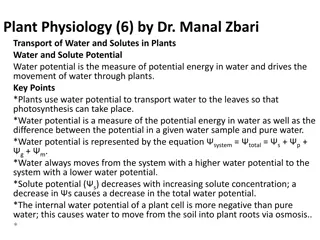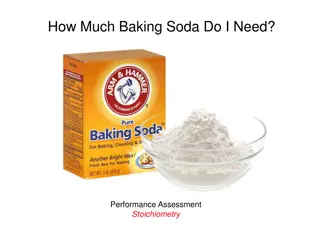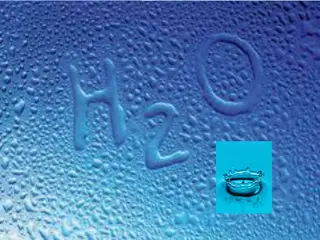Investigating Raisin Osciilations in Soda Water
Understand the phenomenon of raisins oscillating in soda water through an experiment investigating the correlation between mass and oscillation period. The experiment explores how carbon dioxide bubbles affect the raisins' movement, with variables such as mass, surface area, and temperature controlled for accuracy.
Download Presentation

Please find below an Image/Link to download the presentation.
The content on the website is provided AS IS for your information and personal use only. It may not be sold, licensed, or shared on other websites without obtaining consent from the author.If you encounter any issues during the download, it is possible that the publisher has removed the file from their server.
You are allowed to download the files provided on this website for personal or commercial use, subject to the condition that they are used lawfully. All files are the property of their respective owners.
The content on the website is provided AS IS for your information and personal use only. It may not be sold, licensed, or shared on other websites without obtaining consent from the author.
E N D
Presentation Transcript
Flotation Liam King, Arthur Kyriakopoulos, Vincent Lu (MSC)
Flotation A piece of a flattened raisin, which is dropped into a glass of soda water, periodically sinks and goes back to the surface. Investigate the dependence of the period of these oscillations on various parameters. (Note: a combination of vinegar and bicarb of soda in water also works quite well).
Aim The aim of this experiment was to understand why raisins oscillated in soda water. And if so, what the correlation between the period of oscillation and mass of the raisin is.
Hypothesis The more mass a raisin has, the less it will oscillate in the water.
What is actually happening? Bubbles are produced and this causes the raisin to oscillate. When the raisins are put in the water and vinegar they sink. The bubbles cause the raisins to rise. This means that the density of the sultanas change as they are made less dense by external gas bubbles.
Variables Period of oscillation (Dependent) Mass of raisin (independent) Surface area of raisin (control) Temperature of room (control) How the raisin was dried and treated (control) Fizziness of soda water (control) Width of beaker (control) Volume of liquid (control) Temperature of water (control) Oscillation height (5cm) (control)
Theory A raisin will oscillate due to carbon dioxide bubbles getting caught in the ridges in the raisins. Once the bubbles pop (being exposed to air), the raisins will return to the bottom of the beaker.
Materials Water Vinegar Bicarb soda Raisins Scale Spoon Beaker Stopwatch
Method Mix water (100ml) and vinegar (150ml) in a beaker. Add bicarb soda (5g) to the beaker. Add one raisin. Use a stopwatch to measure the length of time between each oscillation of the raisin (how long it takes to get to the top and how long it takes to get to the bottom of the beaker).
Results Raisin 1,3,4,9 Surface area (mm) 5*5*5 Volume of raisin (mL^3) 0.2
Results Period of movement Time (seconds) Raisin 1 Mass (212 grams) Odd number indicates a movement up and even numbers indicate a movement down from the raisin. 1 6.14 2 5.28 3 2.56 4 1.35 5 10.28 6 8.1 7 35.43 8 3.41 9 8.35 10 0.89
Results Period of movement Time (seconds) Raisin 3 Mass (205 grams) Odd number indicates a movement up and even numbers indicate a movement down from the raisin. 1 4.08 2 2.93 3 3.59 4 1.96 5 3.48 6 8.41 7 4.91 8 9.2 9 4.73 10 3.61
Results Period of movement Time (seconds) Raisin 4 Mass (242 grams) Odd number indicates a movement up and even numbers indicate a movement down from the raisin. 1 6.42 2 1.22 3 2.99 4 7.06 5 26 6 3.85 7 8 9 10
Results Period of movement Time (seconds) Raisin 9 Mass (250 grams) Odd number indicates a movement up and even numbers indicate a movement down from the raisin. 1 2.58 2 2.51 3 3.59 4 0.94 5 1.9 6 1.43 7 8 9 10
Conclusion The hypothesis was supported that raisins with a greater mass will oscillate less. This is shown from our results as raisin 3 with the smallest mass oscillated the most and raisin 9 with the greatest mass oscillated the least.


